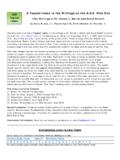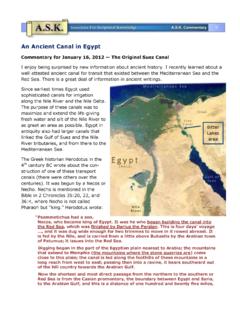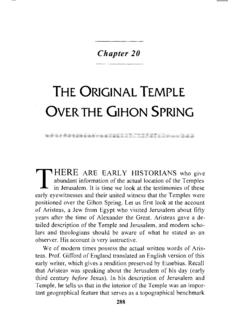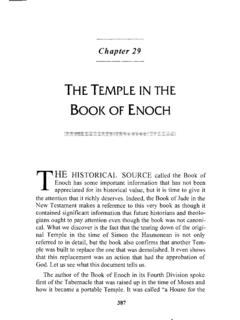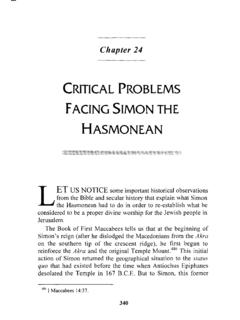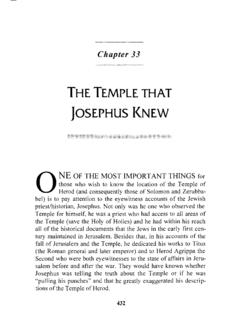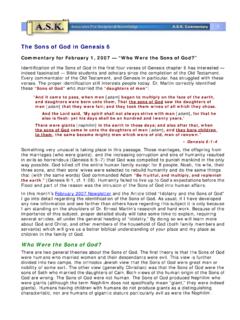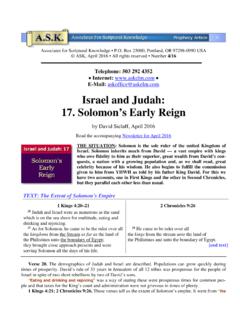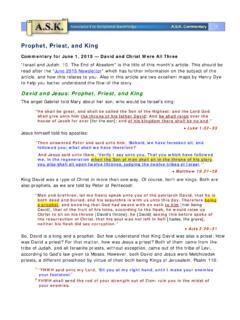Transcription of THE CITY OF DAVID - askelm.com
1 Chapter 23 THE CITY OF DAVID AND THE 0 PHEL B EF 0 RE THE TIME of Simon the Hasmonean the City of DAVID was positioned at the southern end of this crescent-shaped ridge and it was relatively high in eleva-tion. As I have consistently shown in this book, the records show that the City of DAVID was then called the Akra (the Citadel) and its summit was at first higher than the Temple mount which was then located on the Ophel knoll about five hundred feet north. The Ophel was naturally a lower summit of that same mountain (a sin-gle mountain ridge) that comprised the southeast ridge. Recall that Aristeas said the original Akra was located close enough to the Temple Mount that it was possible to overlook activities that were going on in the Temple courts in the lower summit area to the north.
2 According to Josephus, the Akra before the time of Simon the Hasmonean was an elevated area higher than the Temple itself. His exact words are: 331 332 The Temples that Jerusalem Forgot "He [Antiochus Epiphanes] burned the finest parts of the city, and pulling down the walls, built [that is, built up] the Akra in the lower city; for it was high enough to overlook the Temple, and it was for this reason that he fortified it with hiE walls and towers, and stationed a Macedonian garrison therein." Josephus was certainly not talking about those in the City of DAVID (the Akra) being able to look down into the Temple courts located a third of a mile north at the Dome of the Rock. This would have been a physical impossibility.
3 We are told in I Maccabees that at this earlier time the "Temple mount [was located] alongside [Greek: para] the Akra.'461 This makes it plain for all to see. The two areas were very close to one another. There are many other historical references to reinforce this conclusion. The Compactness of the Original City of Jerusalem There was an area between the Akra and the Ophel. It was called the "Millo" (or, "Fill In"). When Solomon enlarged the city of Jerusalem, he filled in the area between the Zion and Ophel summits that existed on the southeast ridge. He called the interme-diate space the "Millo" (or, "Fill In"), which was a northern exten-sion of a former "Millo" built on the north side of Zion in the J ebusite period -before the time of The Septuagint Version of the Bible said the original "Millo" was on the north side of the Akra (the Citadel sector of Zion).
4 And so it was. But Solomon enlarged Jerusalem. He extended the origi-nal "Millo" (or, "Fill In") northward to link the City of DAVID with the Ophel summit. This made a type of artificial bridge of earth, stones and rubble that was placed on top of the old areas of Jebus located on the eastern slope of the ridge abutting to the Kedron Valley. Solomon constructed flanking walls on the eastside and on the westside of the southeastern part of the ridge known as the Ophel. Josephus tells us that this "Fill In" reached a height of 400 460 Antiquities ,4 italics are my emphasis and the words in brackets are mme. 461 I Maccabees 13:52. 462 II Samuel 5:9. The Temples that Jerusalem Forgot 333 cubits above the floor of the Kedron Valley (about 600 feet -this answers to a 40/45 story skyscraper in height).
5 463 It was designed as a huge building that had the Temple and adjacent buildings on its level platform on the top. At least, this is how Josephus de-scribed the structure as it existed in his time. Indeed, by the later time of Josephus, he said that Herod greatly enlarged the Temple platform and made it into a square area with dimensions of 600 feet (a stade) on each side. But in the period of Nehemiah, this high wall ascended from the very bottom of the Kedron Valley. It supported the Temple platform and was 150 feet broad on its east side. The southeast corner of this eastern wall was twice called in the Book of Nehemiah "the turning of the wall. '464 The northeast corner of this eastern wall (150 feet to the north) was also twice called in the Book of Nehemiah "the turning of the wall, even unto the corner.
6 "465 This broad wall of the Temple platform was also 150 feet broad on its west side. At this early period, how-ever, the Temple platform itself was a rectangle. The wall is de-scribed as being 500 feet in length on its south and north This is what the eyewitness account of Hecateus of Abdera states when he saw the Temple platform near the time of Alexander the Great. Even though the platform support was smaller in the time of Nehemiah and Alexander the Great than in the period of Herod and Jesus, it was still an imposing edifice. The Over-All View of the Early Temple and Jerusalem In this region of the "Fill In" between the City of DAVID and the Temple on the Ophel summit, Solomon erected several majestic buildings -some were private and others were government edi-fices.
7 One of those was Solomon's own palace. Scholars have long recognized that there are many biblical references to show the nearness of Solomon's palace to the Temple Mount. And there can be no doubt that Solomon built his palace adjacent to the Temple 463 Antiquities ,9. 464 Nehemiah 3: 19-20. 465 Nehemiah 3:24-25. 466 Josephus, Contra Apion 334 The Temples that Jerusalem Forgot (just south of the Temple) in the "Millo" area between the Akra and the Indeed, Solomon's palace abutted directly to the south side of the In the eastern part of this palace was an area where political prisoners could be confined. This accounts for the east gate leading into this area as the "Prison Gate.
8 " This is where Jeremiah the prophet was imprisoned. "And Jeremiah was shut up in the Court of the Prison, which was in the king of Judah's house."469 This Prison Gate in the east wall led directly into the courts of the royal residence (called the "king's high house" in Nehemiah 3:25). Just to the north of the Prison Gate was the Water Gate (Nehe-miah 3 :26) which was opposite the Gihon Spring (hence the reason for its name). The Water Gate had the Ophel summit (the Temple Mount) directly to its Just north of the Water Gate was "the Wall of Ophel.'471 This "Wall of Ophel" was the rampart that defended the eastern aspect of the Ophel summit. So, the Prison Gate was just east of Solomon's former palace, while the Water Gate (above the Gihon Spring) was just east of the Ophel (or the Temple itself).
9 The southern Prison Gate and the northern Water Gate were dual or adjacent gates. The description in the Book of Nehemiah is clear on this matter. There were also "caves" and "tunnels" in the subterranean area of the Ophel. These were con-structed to lead to the spring water at the Gihon 467 See International Standard Bible Encyclopedia, New Edition, article "Jeru-salem." 468 I Kings 10:5; II Chronicles 9:4; I Chronicles 26: 16. 469 Jeremiah 32:2. 470 Nehemiah 3:26. 471 Nehemiah 3:27. 472 The terms "Mount Zion" and the "Temple Mount" are synonymous. They refer to the same place - to the spur of the southeast ridge where the original "Mount Zion" and its northerly extension called the "Ophel'' were located.
10 For accuracy's sake, all the Temples were located on the "Ophel" prominence situ-ated over and around the Gihon Spring. The Temple was built on the "Ophel" (the "humped mount") that was over the Gihon Spring. Note that in Isaiah 32: 14 (where "Ophel" is translated "forts" in the KJV), Isaiah said some of the main geographical features of the Ophel were its "caves" (KJV: "dens") that were located underneath and within the mountain ridge. In later times, Maimonides The Temples that Jerusalem Forgot 335 All of these topographical indications show the relative near-ness of the City of DAVID to Solomon's palace that was alongside the southern wall of the Temple. The geographical layout gave the appearance that Jerusalem had been "compacted" -a matter of being "brought together" into a being a unified city on a single mountain ridge.
